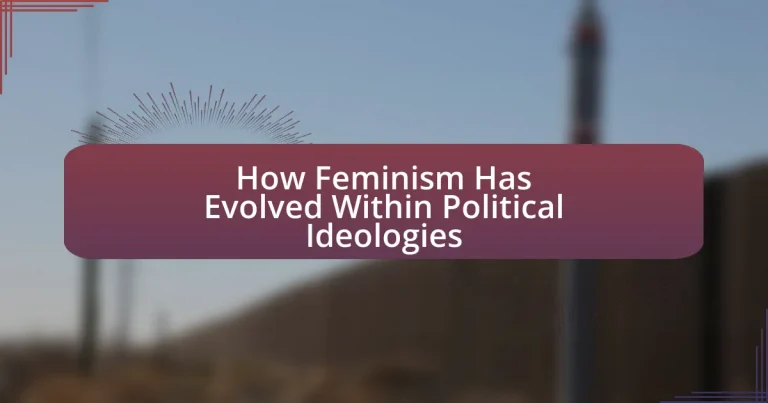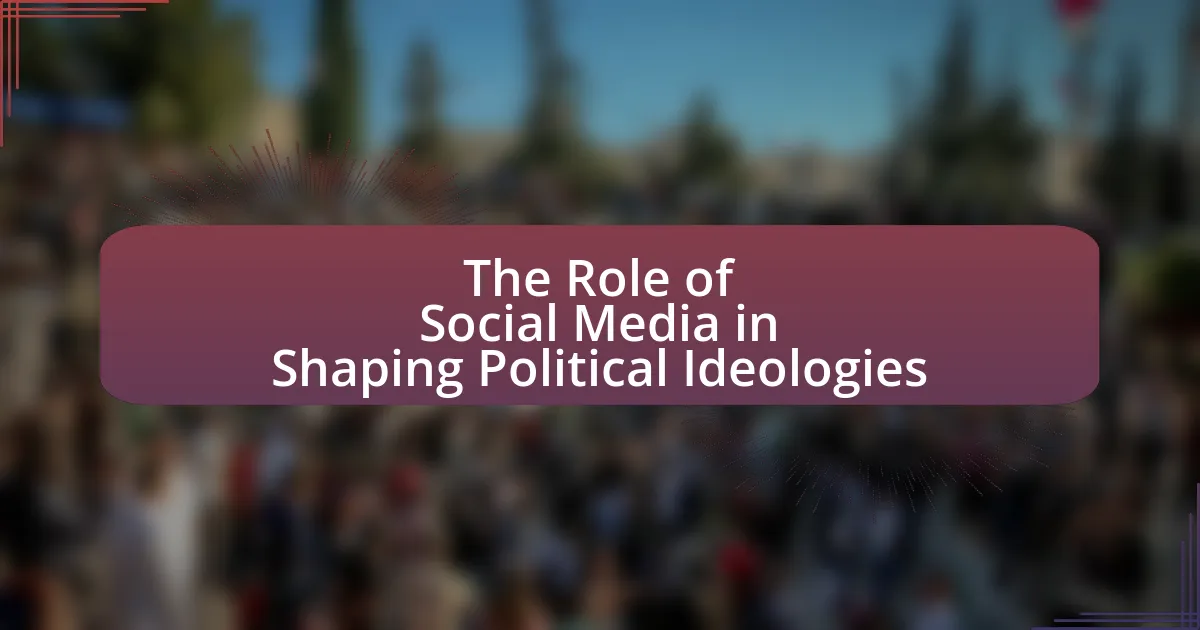Feminism has undergone significant evolution within political ideologies, transitioning from a focus on legal equality in the late 19th and early 20th centuries to a broader critique of social structures and power dynamics. Key historical milestones, such as the Seneca Falls Convention and the publication of “The Feminine Mystique,” have shaped feminist movements and their political impact. The first wave emphasized suffrage and legal rights, while the second wave introduced issues like reproductive rights and workplace discrimination. The third wave further diversified feminist discourse by promoting intersectionality and inclusivity, addressing the complexities of identity and systemic inequalities. Various feminist perspectives, including liberal, radical, socialist, and intersectional feminism, contribute to a comprehensive understanding of gender issues within political contexts, while contemporary challenges include backlash against feminist principles and the influence of misinformation on public perception.
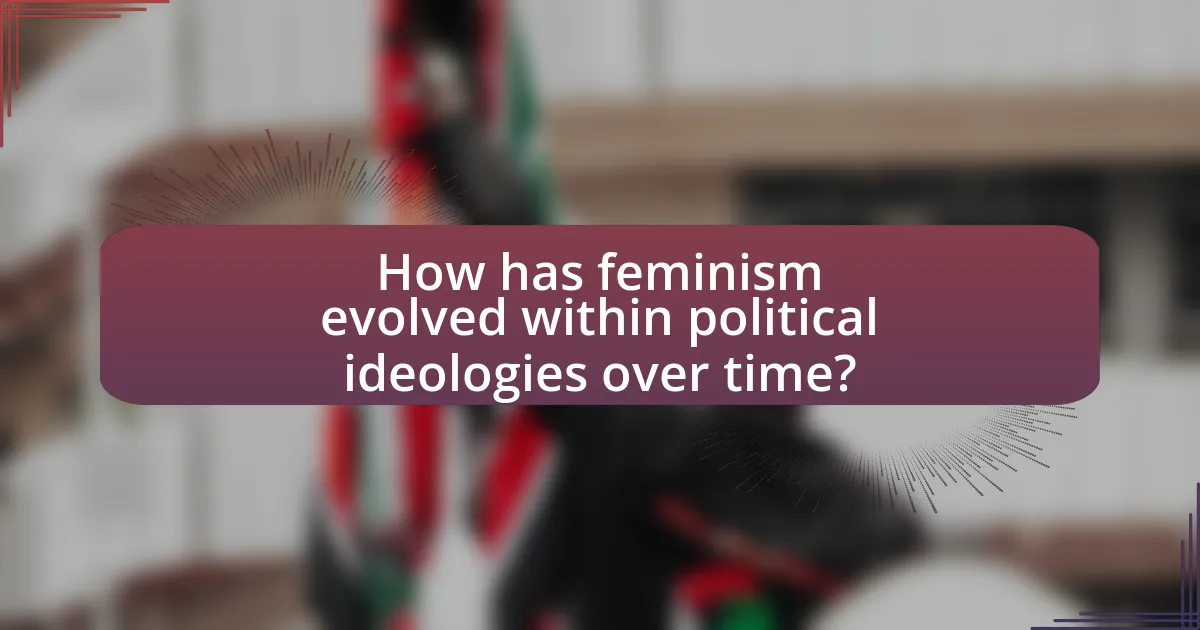
How has feminism evolved within political ideologies over time?
Feminism has evolved within political ideologies from a focus on legal equality to a broader critique of social structures and power dynamics. Initially, in the late 19th and early 20th centuries, feminism primarily sought suffrage and legal rights, aligning closely with liberal political ideologies that emphasized individual rights and equality under the law. As the feminist movement progressed into the mid-20th century, particularly during the 1960s and 1970s, it began to incorporate socialist and radical perspectives, emphasizing the intersection of gender with class, race, and other forms of oppression. This shift was marked by the emergence of second-wave feminism, which critiqued not only legal inequalities but also cultural norms and institutional practices that perpetuated gender discrimination. By the late 20th and early 21st centuries, feminism further diversified, embracing postmodern and intersectional frameworks that recognize the complexity of identity and the multiplicity of experiences among women. This evolution reflects a broader understanding of power and oppression within various political ideologies, demonstrating that feminism is not monolithic but rather a dynamic movement that adapts to changing social and political contexts.
What are the key historical milestones in the evolution of feminism?
Key historical milestones in the evolution of feminism include the Seneca Falls Convention in 1848, which marked the first organized women’s rights movement in the United States, and the publication of “The Feminine Mystique” by Betty Friedan in 1963, which sparked the second wave of feminism. The Seneca Falls Convention produced the Declaration of Sentiments, demanding equal rights for women, while Friedan’s work highlighted the dissatisfaction of women in post-World War II America, leading to increased activism for gender equality. Additionally, the passage of the 19th Amendment in 1920 granted women the right to vote in the U.S., representing a significant legal victory for the feminist movement. Each of these milestones reflects critical shifts in societal attitudes and legal frameworks regarding women’s rights.
How did the first wave of feminism shape political ideologies?
The first wave of feminism significantly shaped political ideologies by advocating for women’s suffrage and legal rights, which laid the groundwork for broader discussions on equality and social justice. This movement, primarily occurring in the late 19th and early 20th centuries, emphasized the importance of women’s participation in the political sphere, leading to the eventual passage of laws granting women the right to vote in various countries, such as the 19th Amendment in the United States in 1920. The push for women’s rights during this period influenced liberal political ideologies by integrating gender equality into the discourse on individual rights and citizenship, thereby challenging traditional patriarchal structures.
What impact did the second wave of feminism have on political discourse?
The second wave of feminism significantly transformed political discourse by introducing issues such as gender equality, reproductive rights, and workplace discrimination into mainstream political conversations. This movement, which gained momentum in the 1960s and 1970s, challenged traditional gender roles and advocated for women’s rights, leading to legislative changes like the Equal Pay Act of 1963 and Title IX in 1972. The activism and scholarship from this era reshaped political agendas, compelling political parties to address women’s issues more directly and influencing public policy debates. As a result, the second wave of feminism not only broadened the scope of political discourse but also established a framework for future feminist movements, ensuring that women’s rights remained a critical component of political dialogue.
How has the third wave of feminism influenced contemporary political ideologies?
The third wave of feminism has significantly influenced contemporary political ideologies by promoting intersectionality and inclusivity in feminist discourse. This wave, emerging in the 1990s, emphasized the importance of diverse identities, including race, class, and sexuality, which reshaped political agendas to address a broader range of social justice issues. For instance, contemporary political movements now often incorporate feminist perspectives that advocate for policies addressing systemic inequalities, such as healthcare access, reproductive rights, and anti-discrimination laws. The influence is evident in the rise of feminist political candidates and organizations that prioritize intersectional approaches, reflecting the diverse experiences of women and marginalized groups in political platforms.
What are the different feminist perspectives within political ideologies?
Different feminist perspectives within political ideologies include liberal feminism, radical feminism, socialist feminism, and intersectional feminism. Liberal feminism advocates for gender equality through legal reforms and policy changes, emphasizing individual rights and opportunities. Radical feminism critiques patriarchy and seeks to dismantle systemic structures that perpetuate male dominance, focusing on cultural and social change. Socialist feminism combines Marxist and feminist theories, arguing that capitalism and patriarchy are interconnected systems of oppression, advocating for both economic and gender justice. Intersectional feminism highlights how various social identities, such as race, class, and sexuality, intersect to create unique experiences of oppression, stressing the importance of addressing these complexities in feminist discourse. Each perspective contributes to a broader understanding of gender issues within political contexts.
How does liberal feminism approach political ideologies?
Liberal feminism approaches political ideologies by advocating for gender equality through legal and political reforms within existing structures. This perspective emphasizes individual rights, equal opportunities, and the importance of participation in political processes to achieve social change. For instance, liberal feminists support policies such as equal pay legislation and anti-discrimination laws, which aim to dismantle systemic barriers to women’s participation in society. Historical milestones, such as the passage of the Equal Pay Act of 1963 in the United States, exemplify the effectiveness of liberal feminist strategies in influencing political ideologies to promote gender equity.
What are the core tenets of radical feminism in political contexts?
The core tenets of radical feminism in political contexts include the belief that patriarchy is the primary source of women’s oppression, the necessity for women’s liberation through systemic change, and the critique of traditional gender roles. Radical feminists argue that societal structures are inherently male-dominated, which perpetuates inequality and violence against women. They advocate for the dismantling of these structures, emphasizing the importance of women’s autonomy and the need for a radical rethinking of social norms and institutions. Historical movements, such as the Women’s Liberation Movement of the 1960s and 1970s, exemplify these tenets by pushing for legal reforms and social awareness regarding issues like reproductive rights and sexual violence, highlighting the urgency of addressing systemic gender-based injustices.
How does socialist feminism integrate class struggle with feminist theory?
Socialist feminism integrates class struggle with feminist theory by asserting that the oppression of women is intrinsically linked to the capitalist system, which perpetuates both gender and class inequalities. This perspective emphasizes that true gender equality cannot be achieved without addressing the economic structures that exploit both women and the working class. Historical evidence, such as the works of socialist feminists like Silvia Federici and Angela Davis, illustrates that the labor of women, particularly in domestic and reproductive roles, is undervalued within capitalist economies, reinforcing their subordination. Thus, socialist feminism advocates for a dual approach that seeks to dismantle both patriarchy and capitalism to achieve comprehensive social justice.
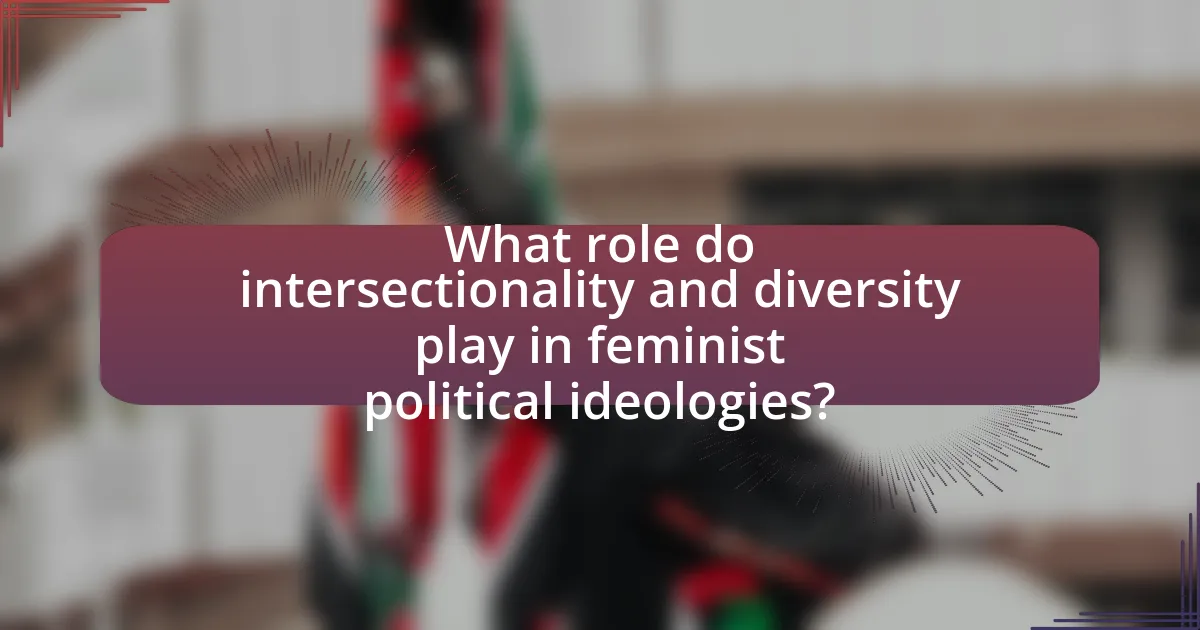
What role do intersectionality and diversity play in feminist political ideologies?
Intersectionality and diversity are fundamental to feminist political ideologies as they highlight the interconnected nature of social categorizations and their impact on women’s experiences. Intersectionality, a term coined by Kimberlé Crenshaw in 1989, emphasizes that individuals face multiple, overlapping forms of discrimination based on race, class, gender, sexuality, and other identities, which shapes their unique experiences of oppression. This framework allows feminist movements to address the needs of diverse groups of women rather than adopting a one-size-fits-all approach.
Diversity within feminist political ideologies ensures that the voices and experiences of marginalized women are included, fostering a more comprehensive understanding of gender inequality. For instance, the inclusion of Black feminist thought, as articulated by scholars like bell hooks and Audre Lorde, challenges mainstream feminist narratives that often center white, middle-class women. This approach not only enriches feminist discourse but also promotes solidarity among women from various backgrounds, ultimately leading to more effective advocacy for social justice.
Research indicates that feminist movements that embrace intersectionality and diversity are more successful in mobilizing support and achieving policy changes, as they resonate with a broader audience and address systemic inequalities more effectively.
How does intersectionality enhance our understanding of feminism in politics?
Intersectionality enhances our understanding of feminism in politics by highlighting how various social identities, such as race, class, gender, and sexuality, intersect to shape individual experiences of oppression and privilege. This framework allows for a more nuanced analysis of political issues, as it recognizes that women’s experiences are not monolithic and that policies must address the diverse needs of all women. For instance, Kimberlé Crenshaw, who coined the term “intersectionality,” illustrated how Black women face unique challenges that are not adequately addressed by mainstream feminist movements, which often prioritize the experiences of white women. By incorporating intersectionality, feminist political discourse can better advocate for inclusive policies that reflect the realities of marginalized groups, ultimately leading to more equitable political outcomes.
What are the implications of race and ethnicity on feminist political movements?
Race and ethnicity significantly influence feminist political movements by shaping the priorities, experiences, and strategies of activists. For instance, Black feminism emphasizes the intersectionality of race, gender, and class, highlighting how systemic oppression affects women of color differently than white women. This perspective was notably articulated by scholars like Kimberlé Crenshaw, who introduced the concept of intersectionality in the late 1980s, illustrating that traditional feminist movements often overlook the unique challenges faced by women of diverse racial and ethnic backgrounds. Additionally, the inclusion of diverse voices in feminist discourse has led to broader coalitions and more comprehensive approaches to issues such as reproductive rights, labor rights, and violence against women, as seen in movements like the Women of Color Collective and the #SayHerName campaign. These movements advocate for policies that address the specific needs of marginalized communities, demonstrating that race and ethnicity are crucial in shaping feminist agendas and activism.
How do class and socioeconomic status intersect with feminist ideologies?
Class and socioeconomic status significantly intersect with feminist ideologies by influencing the experiences and priorities of women within the feminist movement. Feminism recognizes that women’s oppression is not solely based on gender but is also shaped by class and economic conditions, leading to diverse feminist perspectives such as intersectional feminism. For instance, Black feminist theorists like bell hooks argue that the struggles of women of color are compounded by both racism and classism, highlighting that mainstream feminist movements often overlook these intersections. Additionally, socioeconomic disparities affect access to resources, education, and political power, which can limit the effectiveness of feminist advocacy for lower-income women. Studies show that women in lower socioeconomic brackets face unique challenges, such as higher rates of domestic violence and limited access to healthcare, which necessitate a more inclusive feminist approach that addresses these specific issues.
What challenges do feminist movements face within political ideologies today?
Feminist movements today face significant challenges within political ideologies, primarily due to the fragmentation of feminist goals and the rise of backlash against gender equality. The diversity of feminist perspectives, including liberal, radical, and intersectional feminism, often leads to internal conflicts that dilute collective action. Additionally, political ideologies such as conservatism and populism frequently oppose feminist principles, framing gender equality as a threat to traditional values. For instance, in various countries, conservative political parties have enacted policies that roll back reproductive rights and undermine gender equality initiatives, reflecting a broader societal resistance to feminist advancements. This resistance is evidenced by the increasing number of anti-feminist movements and rhetoric that seek to delegitimize feminist discourse in political arenas.
How do backlash and resistance manifest against feminist political ideologies?
Backlash and resistance against feminist political ideologies manifest through various forms of social, political, and cultural opposition. This opposition often includes legislative efforts to roll back women’s rights, such as restrictions on reproductive health services, which can be seen in the enactment of laws limiting access to abortion in several U.S. states since the 2010s. Additionally, cultural backlash is evident in media portrayals that undermine feminist narratives, often depicting feminists as extreme or irrational, which can discourage public support for feminist causes. Furthermore, organized movements, such as men’s rights activism, actively challenge feminist principles by promoting traditional gender roles and opposing gender equality initiatives. These manifestations highlight the ongoing struggle between feminist ideologies and societal resistance, reflecting deep-seated tensions regarding gender equality and women’s rights.
What role does misinformation play in shaping public perception of feminism?
Misinformation significantly distorts public perception of feminism by perpetuating stereotypes and misconceptions about its goals and values. For instance, false narratives often portray feminism as anti-male or extremist, which can alienate potential allies and misrepresent the movement’s focus on gender equality. Research indicates that media portrayals and social media discourse frequently amplify these inaccuracies, leading to a skewed understanding of feminist principles. A study published in the journal “Gender & Society” highlights that negative framing in media can reinforce societal biases, further complicating the public’s grasp of feminism’s true objectives.
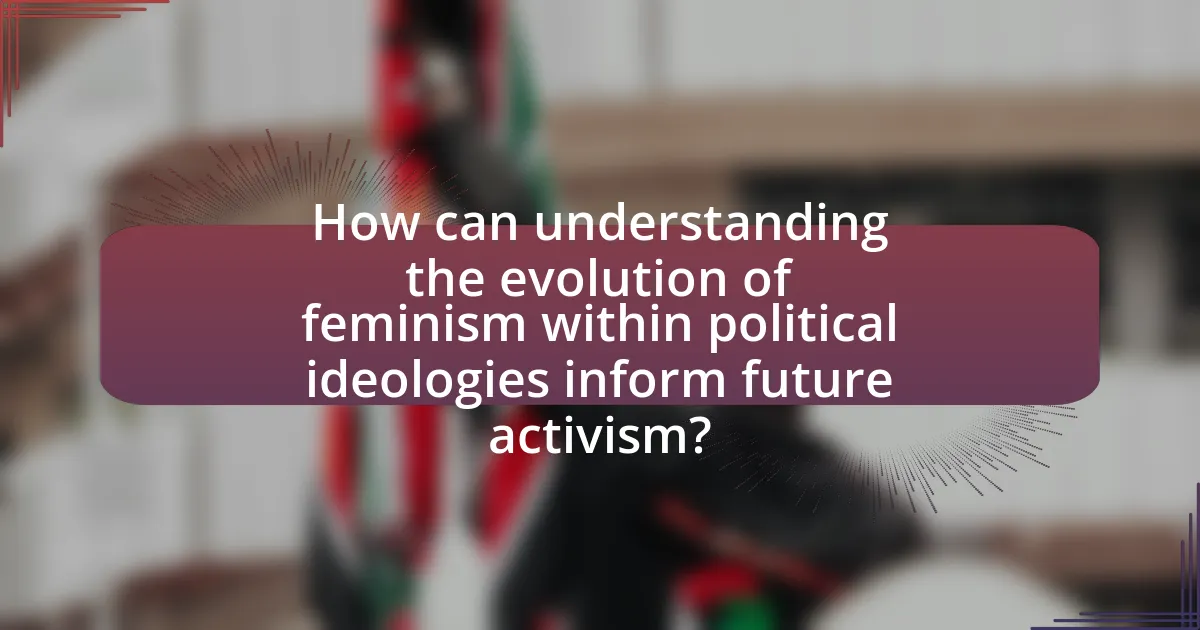
How can understanding the evolution of feminism within political ideologies inform future activism?
Understanding the evolution of feminism within political ideologies can inform future activism by highlighting the historical context and ideological frameworks that shape feminist movements. For instance, the first wave of feminism focused on legal issues and inequalities, such as women’s suffrage, while the second wave expanded to include issues of sexuality, family, and workplace rights, influenced by civil rights movements. This historical progression illustrates how different political ideologies, such as liberalism and socialism, have impacted feminist goals and strategies. By analyzing these shifts, activists can identify successful tactics and adapt them to contemporary issues, ensuring that future movements are inclusive and responsive to the diverse needs of women across various socio-political landscapes.
What strategies can activists employ to promote feminist ideals in politics?
Activists can employ strategies such as grassroots organizing, coalition-building, and advocacy for policy change to promote feminist ideals in politics. Grassroots organizing involves mobilizing community members to raise awareness and influence local political agendas, as seen in movements like the Women’s March, which brought millions together to advocate for women’s rights. Coalition-building allows activists to unite with other social justice movements, amplifying their voices and creating a broader impact, exemplified by the collaboration between feminist groups and racial justice organizations. Advocacy for policy change includes lobbying for legislation that supports gender equality, such as the Equal Rights Amendment, which has been a focal point for feminist activists seeking constitutional guarantees for women’s rights. These strategies collectively enhance the visibility and influence of feminist ideals within political discourse.
How can coalitions between different feminist movements strengthen political impact?
Coalitions between different feminist movements can strengthen political impact by uniting diverse perspectives and resources, thereby amplifying their collective voice. When various feminist groups collaborate, they can address a broader range of issues, such as intersectionality, which recognizes how race, class, and gender intersect to create unique experiences of oppression. For instance, the collaboration between Black feminists and mainstream feminist organizations has historically led to more inclusive policies that consider the needs of marginalized women. This unity can also enhance lobbying power, as seen in the 2017 Women’s March, which brought together various feminist groups to advocate for women’s rights on a global scale, demonstrating that collective action can lead to significant political influence and policy changes.
What lessons can be learned from historical feminist movements for contemporary activism?
Historical feminist movements teach contemporary activism the importance of intersectionality, grassroots organizing, and the necessity of coalition-building. Intersectionality, as articulated by Kimberlé Crenshaw, emphasizes that various social identities, such as race, class, and gender, intersect to create unique experiences of oppression, which activists must consider to address the needs of all women effectively. Grassroots organizing, exemplified by the suffragette movement, demonstrates that local, community-driven efforts can lead to significant political change, as seen in the passage of the 19th Amendment in the United States. Additionally, coalition-building, highlighted during the Women’s Liberation Movement of the 1960s and 1970s, shows that uniting diverse groups can amplify voices and create broader societal impact, as evidenced by the success of the March on Washington for Jobs and Freedom in 1963. These lessons underscore the need for a multifaceted approach in contemporary feminist activism.
What practical steps can individuals take to support feminist political ideologies?
Individuals can support feminist political ideologies by actively engaging in advocacy, education, and community involvement. Advocacy can include participating in campaigns that promote gender equality, such as supporting legislation that addresses issues like pay equity and reproductive rights. Education involves informing oneself and others about feminist theories and the historical context of women’s rights, which can be achieved through reading feminist literature and attending workshops or lectures. Community involvement can take the form of volunteering with organizations that focus on women’s issues, such as shelters for survivors of domestic violence or groups that promote women’s health. These actions contribute to a broader societal understanding of feminist principles and help to create a supportive environment for gender equality initiatives.
How can grassroots movements effectively advocate for feminist policies?
Grassroots movements can effectively advocate for feminist policies by mobilizing community support, raising awareness, and influencing policy through direct action. These movements often utilize social media platforms to disseminate information quickly, engage a broader audience, and create a sense of urgency around feminist issues. For instance, the #MeToo movement demonstrated how grassroots activism can lead to significant policy changes regarding sexual harassment laws in various jurisdictions. Additionally, grassroots organizations often collaborate with local leaders and stakeholders to ensure that feminist policies reflect the needs and voices of the community, thereby increasing the likelihood of successful implementation. Research indicates that grassroots advocacy can lead to legislative changes, as seen in the 2018 Women’s March, which galvanized millions and influenced political discourse around women’s rights.
What role does education play in advancing feminist political ideologies?
Education plays a crucial role in advancing feminist political ideologies by empowering individuals with knowledge about gender equality, social justice, and women’s rights. Through education, individuals learn about the historical context of feminism, the systemic inequalities faced by women, and the importance of advocacy and activism. Studies have shown that higher levels of education correlate with increased awareness and support for feminist issues, as educated individuals are more likely to challenge traditional gender roles and engage in political discourse. For instance, research from the World Economic Forum indicates that countries with higher female education levels tend to have more progressive gender policies, demonstrating the direct impact of education on the advancement of feminist political ideologies.
